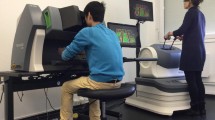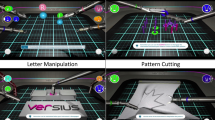Abstract
Background
Validated training exercises are essential tools for surgeons as they develop technical skills to use robot-assisted minimally invasive surgical systems. The purpose of this study was to show face, content, and construct validity of four, inanimate training exercises using the da Vinci ® Si surgical system configured with Single-Site ™ instrumentation.
Methods
New (N = 21) and experienced (N = 6) surgeons participated in the study. New surgeons (11 Gynecology [GYN] and 10 General Surgery [GEN]) had not completed any da Vinci Single-Site cases but may have completed multiport cases using the da Vinci system. They participated in this study prior to attending a certification course focused on da Vinci Single-Site instrumentation. Experienced surgeons (5 GYN and 1 GEN) had completed at least 25 da Vinci Single-Site cases. The surgeons completed four inanimate training exercises and then rated them with a questionnaire. Raw metrics and overall normalized scores were computed using both video recordings and kinematic data collected from the surgical system.
Results
The experienced surgeons significantly outperformed new surgeons for many raw metrics and the overall normalized scores derived from video review (p < 0.05). Only one exercise did not achieve a significant difference between new and experienced surgeons (p = 0.08) when calculating an overall normalized score using both video and advanced metrics derived from kinematic data. Both new and experienced surgeons rated the training exercises as appearing, to train and measure technical skills used during da Vinci Single-Site surgery and actually testing the technical skills used during da Vinci Single-Site surgery.
Conclusions
In summary, the four training exercises showed face, content, and construct validity. Improved overall scores could be developed using additional metrics not included in this study. The results suggest that the training exercises could be used in an overall training curriculum aimed at developing proficiency in technical skills for surgeons new to da Vinci Single-Site instrumentation.



Similar content being viewed by others
References
Haber G-P et al (2010) Novel robotic da Vinci instruments for laparoendoscopic single-site surgery. Urology 76(6):1279–1282
Kroh M et al (2011) First human surgery with a novel single-port robotic system: cholecystectomy using the da Vinci Single-Site platform. Surg Endosc 25(11):3566–3573
Intuitive Surgical, Inc. http://intuitivesurgical.com/products/davinci_surgical_system/da-vinci-single-site/#sthash.GSA9056f.dpuf. Accessed 17 Jul 2014
Finnegan KT et al (2012) da Vinci Skills Simulator construct validation study: correlation of prior robotic experience with overall score and time score simulator performance. Urology 80(2):330–336
Hung AJ et al (2012) Concurrent and predictive validation of a novel robotic surgery simulator: a prospective, randomized study. The Journal of urology 187(2):630–637
Hung AJ et al (2011) Face, content and construct validity of a novel robotic surgery simulator. J Urol 186(3):1019–1025
Kelly DC et al (2012) Face, content, and construct validation of the da Vinci Skills Simulator. Urology 79(5):1068–1072
McDougall EM (2007) Validation of surgical simulators. J Endourol 21(3):244–247
Green I et al (2013) Creating a validated robotic curriculum for resident and fellow education. J Minim Invasive Gynecol 20(6):S130–S130
Jarc AM, Curet M (2014) Construct validity of nine new inanimate exercises for robotic surgeon training using a standardized setup. Surg Endosc 28(2):648–656
Smith R, Patel V, Satava R (2013) Fundamentals of robotic surgery: a course of basic robotic surgery skills based upon a 14‐society consensus template of outcomes measures and curriculum development. Int J Med Robot 10(3):379–384
Aghazadeh M et al (2014) Multi-institutional validation of fundamental inanimate robotic skills tasks (FIRST). J Urol 191(4 Supplement):e130–e131
Dulan G et al (2012) Proficiency-based training for robotic surgery: construct validity, workload, and expert levels for nine inanimate exercises. Surg Endosc 26(6):1516–1521
DiMaio S, Hasser C (2008) The da Vinci research interface in MICCAI workshop on systems and architectures for computer assisted interventions, MIDAS J. http://hdl.handle.net/10380/1464
Rosen J. et al. The BlueDRAGON-a system for measuring the kinematics and dynamics of minimally invasive surgical tools in vivo in Robotics and Automation, 2002. Proceedings. ICRA’02. IEEE International Conference on 2002: IEEE
Ruda K et al (2013) SurgTrak—a universal platform for quantitative surgical data capture. J Med Devices 7(3):030923
Ramos P et al (2013) Validation of dry lab exercises for robotic training using global assessment tool. J Urol 189(4):e642
Disclosures
A. M. Jarc is a researcher in the Medical Research group at Intuitive Surgical Inc. M. Curet is a Senior Vice President and Chief Medical Officer at Intuitive Surgical Inc.
Author information
Authors and Affiliations
Corresponding author
Rights and permissions
About this article
Cite this article
Jarc, A.M., Curet, M. Face, content, and construct validity of four, inanimate training exercises using the da Vinci ® Si surgical system configured with Single-Site ™ instrumentation. Surg Endosc 29, 2298–2304 (2015). https://doi.org/10.1007/s00464-014-3947-2
Received:
Accepted:
Published:
Issue Date:
DOI: https://doi.org/10.1007/s00464-014-3947-2




